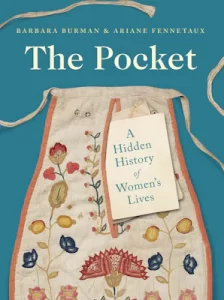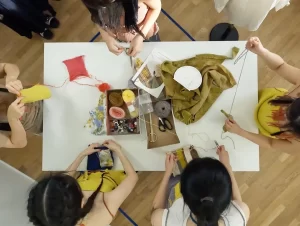텍스텀 클럽(Textum Club)은 패션비평과 관련된 프랙티스와 출판을 위한 연구모임입니다. 직물을 뜻하는 ‘textile’과 글을 의미하는 ‘text’의 공통 어원인 ‘엮다’는 뜻을 가진 텍스텀 클럽은 패션 비평 아카이브로써 비평적 패션(Critical Fashion) 관련 국내외의 도서를 소개합니다.
비평적 패션 프로젝트 및 담론의 지속적 연구와 확산을 위해 전시, 출판, 연구, 워크숍 등 다양한 활동을 추진하여 국내외의 디자이너, 예술가, 연구자, 패션종사자의 네트워크장으로써 기능하고자 합니다.
Textum Club is a research group dedicated to practices and publishing in fashion criticism based in Seoul. Derived from the common roots of 'textile' and 'text,' meaning 'to weave,' Textum Club introduces books and articles related to critical fashion as part of its fashion criticism archive.
It aims to serve as a networking platform for designers, artists, researchers, and fashion practitioners globally through various activities including exhibitions, publishing, research, and workshops.
テキスタムクラブ(Textum Club)は、ファッション批評に関する実践と出版のためのリサーチグループです。布地を意味する「textile」と、文章を意味する「text」という言葉の共通の語源である「編む(texere)」という概念に基づくテキスタムクラブは、ファッション批評のアーカイブとして、クリティカル・ファッション(Critical Fashion)に関連する各国の書籍を紹介しています。
批評的ファッションのプロジェクトやディスコースの継続的な研究と普及を目指し、展覧会、出版、リサーチ、ワークショップなど多様な活動を展開しながら、各国のデザイナー、アーティスト、研究者、ファッション関係者のネットワークの場として機能することを目指しています。
-
김서희는 세히쿄(SEHIKYO) 프로젝트를 운영하며 착용자들과 협업하는 방식으로 옷을 입는 아이디어를 공유하고 있습니다. 전시, 워크숍, 프레젠테이션을 통해 전통적 패션 시스템에 의존하지 않는 대안적 프랙티스를 연구하고자 합니다.
www.sehikyo.orgThe SEHIKYO project is managed by Seohee Kim, who shares innovative ideas about clothing through collaboration with wearers. Through exhibitions, workshops, and presentations, she explores alternative practices that challenge the traditional fashion system, aiming to establish a new paradigm in how fashion is perceived and practiced. More details about her work and contributions can be found on the www.sehikyo.org
キム・ソヒはSEHIKYO(セヒキョ)プロジェクトを運営し、着用者との協働を通じて「服を着る」というアイデアを共有しています。展覧会、ワークショップ、プレゼンテーションを通して、従来のファッションシステムに依存しない代替的なプラクティスの探求を目指しています。www.sehikyo.org
-
김연우는 큐레이터, 연구자, 제작자로 활동하고 있으며, 텍스텀 클럽의 공동 창립자로서 패션 비평과 관련된 연구, 전시, 출판 활동을 수행하고 있습니다. 그녀는 2023 청주 공예 비엔날레를 비롯하여 서울과 제주에서 공예와 예술 관련 다양한 전시를 큐레이션했습니다. 연세대학교에서 철학과 의류환경을 공부한 후, 센트럴 세인트 마틴과 영국 왕립 예술 대학교에서 패션을 전공했습니다. 그녀는 패션 현상의 철학적 분석에 대한 이론과 실천을 연구하며, 패션에 대한 대안적인 시각을 제공하고자 합니다.
www.fashionknowledgehoarder.comYeonwoo Kim works as a curator, researcher, and maker, and is a co-founder of Textum Club, where she engages in research, exhibitions, and publishing related to fashion criticism. She has curated various craft and art exhibitions in cities including Seoul and Jeju, notably the 2023 Cheongju Craft Biennale. After studying philosophy and clothing environment at Yonsei University, she pursued fashion at Central Saint Martins and the Royal College of Art in the UK. She researches the theory and practice of philosophical analysis of fashion phenomena, aiming to provide an alternative perspective on fashion. More details about her work and contributions can be found on the www.fashionknowledgehoarder.com
キム・ヨヌはキュレーター、研究者、そしてクリエイターとして活動しており、テキスタムクラブの共同設立者として、ファッション批評に関するリサーチ、展覧会、出版活動を行っています。彼女は2023年の清州工芸ビエンナーレを含め、ソウルや済州で工芸とアートに関する様々な展覧会をキュレーションしてきました。延世大学で哲学と衣類環境を学んだ後、セントラル・セント・マーチンズおよび英国王立芸術大学でファッションを専攻しました。彼女はファッション現象の哲学的分析に関する理論と実践を研究し、ファッションに対する新たな視点を提示することを目指しています。www.fashionknowledgehoarder.com
-
황혜림은 시각예술 및 공예 분야에서 활동중인 큐레이터입니다. 분단, 장애, 게임, 웹툰 등 경계에 머무는 것들에 대해 많은 관심을 갖고, 연구 및 전시 활동에 참여하고 있습니다.
Hwang Hyerim is a curator active in the fields of visual arts and crafts. She has a keen interest in topics residing at boundaries such as division, disability, gaming, and webtoons, and is involved in research and curatorial projects related to these themes.
ファン・ヘリムは、視覚芸術および工芸の分野で活動しているキュレーターです。分断、障害、ゲーム、ウェブトゥーンなど、境界にとどまるものごとに強い関心を持ち、リサーチや展覧会の活動に取り組んでいます。
-
텍스텀 클럽의 활동에 관심이 있는 여러분의 참여를 환영합니다! 패션과 관련된 책이나 주제를 추천해주세요. 또한 문의사항이 있다면 언제든지 저희에게 메일을 보내주세요.
We welcome your participation in Textum Club’s activities! Please recommend books or topics related to fashion that interest you. If you have any questions, feel free to email us at any time.
テキスタムクラブの活動にご関心のある皆さまのご参加を心よりお待ちしております。ファッションに関する書籍やテーマのご推薦もぜひお寄せください。ご質問などがありましたら、いつでもお気軽にメールでご連絡ください。
textum.club@gmail.com
@textum.club
textum.club@gmail.com
@textum.club
textum.club@gmail.com
@textum.club
내 주머니 속의 손
Hand in My Pocket
Hand in My Pocket
몇 달 전 중고 의류 시장에서 빈티지 코트 한 벌을 샀다. 예전 주인이 꽤 오랜 시간 착용했던 옷인지, 남아있는 흔적을 통해 그의 생활을 엿볼 수 있었다. 안주머니에 들어있는 94년도 주차장 이용권, 드라이클리닝을 맡기면서 기록되었을 세탁소 라벨, 원래 단추 대신 다른 모양의 단추를 꿰매 놓은 흔적…. 등쪽 안감의 중심선이 조금 튿어져 있는 것을 통해 옷주인의 체형을 몰래 짐작해보기도 하고, 첫 번째와 두 번째 단추 구멍이 유독 늘어나 있는 것을 보며 그가 어떻게 옷을 입었을지 어렵지 않게 그려보았다. 또, 특이하게 왼쪽 주머니의 입구가 여전히 실로 봉하여져 있는 데 반해 오른쪽은 안감이 곧 뜯어질 만치 해져 있었는데, 이전 옷주인이 내내 고집스럽게도 오른쪽 주머니만을 사용한 모양이었다. 낡은 옷 한 벌에 켜켜이 쌓인 착용의 역사를 훑으며 그 주인의 생활을 엿보는 일은 꽤 즐거운 일이다. 옷은 다른 어떤 미(美)의 물리적 형태보다 현실세계를 쉬이 반영하며, 매우 사적인 생활의 기록장으로 기능한다.
나는 겨우내 그 코트를 꽤 자주 꺼내 입었다. 많이 닳아 있던 오른쪽 주머니의 안감은 끝내 뜯어져 손바느질로 수선했고, 아마도 30년 동안이나 닫혀 있었을지 모르는 왼쪽 주머니도 개봉했다. 새로운 주인의 등장으로 이제 코트에 또다른 층위(레이어)의 흔적이 새겨지기 시작한 것이다. 최근에는 초콜릿이 주머니에서 껍질도 없이 녹아버리는 바람에 주머니를 아예 새로 달기로 마음먹었다. 하지만 이미 단단히 고정되어 있는 주머니를 떼고 새로 달기란 쉽지 않은 일. 포털 검색창에 ‘How to replace a pocket in a coat’라는 검색어를 입력하여 수선에 도움이 되는 몇 가지 자료를 찾아냈다. 결과적으로, 조금 이질감이 들기는 하지만 꽤 만족스러운 주머니를 만들어 달았다.
자료를 찾던 중에 재미있는 에세이를 읽었다. 역사적 맥락을 바탕으로 17세기 유럽 여성들의 주머니 사용에 담긴 의미를 해석한 글이었다. 이 글에서, 나는 세히쿄의 잠재적 작업 소재로서 ‘주머니’라는 오브제가 갖는 가능성을 확인했다. 이러한 발견은 주머니 사용의 역사에 대한 보다 심층적인 리서치로 이어졌으며, 그 진행과정에서 나는 아주 흥미로운 책 한 권을 발견했다. ⌜The Pocket, A Hidden History of Womens’s lives (Barbara, Ariane, 2019)⌟는 주머니가 가정 안팎에서 가졌던 기능이나 여성들이 가정에서 자신만의 주머니를 만들었던 방법 등, 주머니의 제작과 사용에 관한 역사적 사실을 서술한다.

https://yalebooks.co.uk/book/9780300253740/the-pocket/
(이 책에 의하면,) 17세기에서 20세기에 걸쳐 유럽 여성들에게 허리 주위에 착용하는 탈착식 주머니(Tie-on-pockets)는 ‘평범한-이동식-작은-물건’ 이상의 의미를 가졌다. 책의 저자가 말하듯 주머니는 여성에게 “개인의 삶과 사회적 관행의 교차지대에서 사랑하는 사람과 가족(의 물건)에게 자신의 정체성을 고정해둔 채 지역 사회와 상호작용할 수단”이 되었다. 주머니는 늘 착용자의 신체에 밀착되어 있는 비밀스럽고 사적인 공간으로서 정서적인 애착의 대상인 동시에 그 외양에 새겨진 가문의 문장이나 각양의 자수장식을 통해 사회적 위신이나 개성을 표현하는 수단으로도 기능했다. 원단을 골라 직접 바느질해 만들고, 겉감에 장식이나 개인적인 표식을 자수로 새겨넣는 등 일련의 실용적 창작행위는 가내의 여성 제작자들에게 자아를 표출하는 자유와 해방의 통로가 된 셈이다.
영국 V&A 갤러리 홈페이지에서는 꽤 많은 양의 탈착식 주머니(Tie-on-pockets) 아카이브를 열람할 수 있다. 형태는 서로 크게 다르지 않지만 집집마다 사용한 원단의 종류, 바느질 기법과 수선 방식, 그리고 특히 자수로 장식된 소지자의 표식이 전혀 달라 신분증처럼 느껴질 정도로 개인화(customized)되어있다. 또 분명 의도하지는 않았을 여러 얼룩들이 눈에 띄는데, 가령 흰주머니에 펜 잉크가 번져있는 모양은 마치 금방이라도 주인이 나타나 주머니를 집어들어갈 것 같이 생생하다.
얼핏 정적인 가사 노동으로 보이는 주머니 만들기는 실상 매우 역동적이고 적극적인–때론 투쟁적이기까지 한– 연주(演奏) 행위이다. 주머니를 만들고 메는 일로부터 모두들 저마다 손에 잡히듯 생생한 리듬과 선율을 찾아내길 바라며!
글. 김서희(세히쿄 SEHIKYO)
2023년 여름에 진행된 세히쿄(SEHIKYO)의 두 번째 프레젠테이션은 15분간의 퍼포먼스 «핸드 인 마이 포켓 Hand in my pocket»(2023)을 소개한다. 세히쿄는 수선을 통한 일련의 리서치 과정에서 17세기 유럽의 ‘주머니’가 가내에서 수작업으로 제작되는 과정의 공예성과 착용의 역사를 고스란히 담고 있는 정서적 애착의 대상으로서의 속성에 주목한다. 15분간의 퍼포먼스 «핸드 인 마이 포켓 Hand in my pocket»(2023)은 손바느질 행위로 이루어진 ‘주머니 만들기’를 통해 주머니의 속성에 대한 탐구와 세히쿄의 작업적 실천을 결합한다.

퍼포먼스의 영상은 여기에서 찾아볼 수 있다.
I bought a vintage coat at a second-hand shop a few months ago. Through the remaining traces, I could catch a glimpse of the previous owner’s life, whether it was an article of clothing that the previous owner wore for quite some time. Traces such as a 1994 parking ticket in the coat pocket, a laundry label that would have been recorded when sent for dry cleaning, and evidence of sewing different-shaped buttons instead of the original buttons… Through the slightly curved centerline of the back lining, I secretly guessed the owner’s body shape. I could easily imagine how he or she wore the coat by observing that the first and second buttonholes were abnormally stretched. Moreover, while the entrance of the left pocket was still sewn with thread, the lining of the right pocket was torn, as if it was about to come off. It seemed that the previous owner stubbornly used only the right pocket. It is quite enjoyable to look at the history of the coat’s wear piled up in one old garment and to peek into the owner’s life. Clothes easily reflect the real world more than any other physical form of aesthetics, and function as a very private record of one’s life.
I took the coat out and wore it quite often throughout the winter. I mended the worn lining of the right pocket by hand sewing, and I also opened the left pocket, which may have been closed for 30 years. With the appearance of a new owner, another layer of traces began to be engraved on the coat. Recently, because the chocolate in the pocket melted without its wrapper, I decided to replace the pocket entirely. However, it is not easy to remove the already firmly fixed pocket and replace it. I searched the internet for “How to replace a pocket in a coat” and found some materials that helped with the repair. In the end, I made a pocket that was a little unfamiliar but quite satisfying.
While searching for materials, I came across an interesting essay that interpreted the meaning behind the use of pockets by European women in the 17th century based on historical context. In this essay, I confirmed the potential of pockets as a potential subject for my work. This discovery led me to a deeper research on the history of pocket usage, and during the process, I discovered a very interesting book, “The Pocket: A Hidden History of Women’s Lives” (Barbara, Ariane, 2019), which describes the historical facts about the production and usage of pockets, such as the functions of pockets in and outside of the home and the ways in which women made their own pockets at home.

https://yalebooks.co.uk/book/9780300253740/the-pocket/
According to the book, tie-on pockets, detachable pockets worn around the waist by European women from the 17th to the 20th century, had a meaning beyond that of a “portable-small-spaces”. As the author of the book says, “pockets provided women with a means to situate themselves and anchor their identity in relation to loved ones, family and community.” Pockets were a secret and private space that always adhered to the wearer’s body and served as a means of expressing social status or individuality through family crests or various embroidery decorations engraved on the exterior. The series of practical creative acts, such as choosing fabric and directly sewing it and embroidering decorations or personal marks on the exterior, became a means for female makers in households to express themselves freely and become liberated.
On the website of the V&A Gallery in the UK, a considerable amount of tie-on pockets archives can be viewed. Although the forms are not significantly different from each other, each pocket is personalized through the type of fabric used, sewing techniques, mending methods, and especially the owner’s personal marks embroidered on them, which feel like identification cards. Moreover, several stains that were clearly unintended catch the eye; for example, the ink spilled on a white pocket looks vivid, as if the owner might appear any moment to grab the pocket. SEHIKYO pays attention to the emotional attachment to pockets as an object that encompasses the craftsmanship of the production process within households and the history of wearing them. Making pockets, which may appear to be static household labour, is, in fact, a very dynamic and proactive (sometimes even confrontational) performance. I hope everyone finds their own vivid rhythm and melody from creating and carrying pockets!
Seohee Kim (SEHIKYO)
SEHIKYO’s second presentation introduces the 15-minute performance project «Hand in my pocket»(2023). In a series of research processes from repairs, Sehikyo pays attention to the craftsmanship of the 17th-century European “pocket” being handmade at home and its attributes as an object of emotional attachment that contains the history of wearing. The 15-minute performance «Hand in my pocket»(2023) combines Sehikyo’s practice with the exploration of the properties of pockets through “pocket making” made up of the act of hand sewing.

You can find the video of the performance here.